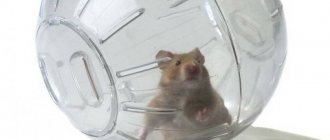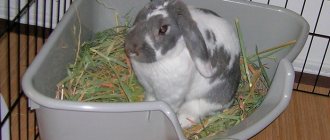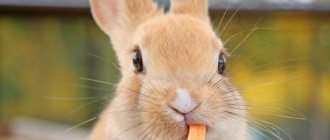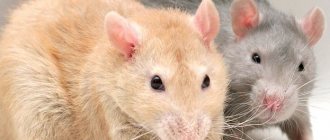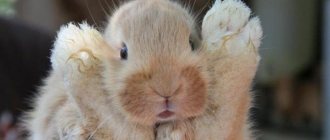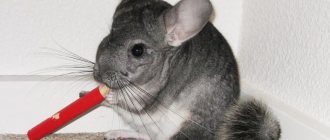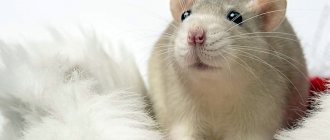Here is information about the pros and cons of keeping rabbits as pets. All information was compiled based on my and other people's life experiences. Be sure to read the entire page before purchasing a rabbit. This is in your interests and the interests of the animal, not to mention your household. And only after that decide whether to have a rabbit in an apartment or a private house.
Advantages:
- They get used to people and many pets, including cats and dogs.
- Dwarf rabbits are small, do not take up much space, eat little, and have little odor.
- Beautiful, fluffy, soft.
- They love to be stroked and, in turn, lick their owners.
- They cost less than the same chinchillas.
- A rabbit can be litter trained.
- A rabbit can be trained to walk on a harness.
- Rabbits love to play, and if you try, you can stop them from chewing wires and wallpaper.
- Rabbits are generally sociable.
- If you also have a cat, you can watch and participate in their games. True, it depends on the characters of the cat and rabbit.
Flaws:
- Rabbits have a lot of their own characteristics, including their content - they are worth knowing inside and out.
- The smell, and a very strong smell if you rarely clean the cage.
- The larger the animal, the more it eats and smells.
- Under no circumstances should you keep a rabbit in the same cage as a guinea pig.
- Rabbits love to chew wires and tear wallpaper; you still need to be able to wean them off this.
- It is more difficult to train a rabbit to use a litter box than a cat, but you will need to do this if you want to let him out of the cage and at the same time protect the apartment from white spots and feces.
- Dwarf rabbits are more susceptible to disease and are significantly more expensive.
- Decorative rabbits are larger in size than dwarf rabbits and have more odor.
- Rabbits are much more susceptible to disease and risk of injury than cats and dogs.
- To keep a rabbit you will need to buy various items, such as: a cage, a drinking bowl, a feeder. They need to regularly buy hay and dry food in granules.
- The temperament of rabbits, especially female rabbits, can be explosive. So, during the rut, one decorative rabbit dragged a huge Persian cat by the tail and pulled out tufts of fur from him, and when she was put in a cage, she shook the bars with her paws, chewed them with her teeth, and threw bowls around.
- If a rabbit doesn't like you sticking your hands into its cage, it may strike with its clawed front paws, and some rabbits may even bite.
- Have you heard the rabbits hissing and growling? If you're unlucky, you'll hear it.
- As I said above, you need to know the characteristics of rabbits. So, for example, they can scare an ignorant owner by falling on their back and rolling their eyes, but, by the way, they do this out of a great mood and pleasure. Or, for example, if the baby rabbits have diarrhea, then they must be urgently taken to the veterinarian, because without professional intervention they may not live even two days.
Is it worth having a rabbit in an apartment, pros or cons?
It is not human nature to listen to other people's opinions. How much did you listen to your mother, and then say, Mom, you were right, and even more so the opinion of Internet advisers on choosing animals. Meanwhile, rabbits are exotic animals for apartment keeping, and exotic animals require special knowledge. Therefore, read our advice, and then decide for yourself whether you are ready to take responsibility for a small living creature.
So, the topic of today’s review is decorative rabbits: pros and cons. How difficult is it to care for a small pet, how to feed it and what should you be wary of? Read about all this right now.
How to avoid diseases
In a greenhouse, it is impossible to achieve a level of sanitation comparable to cage housing. Feces and urine scattered throughout the area contribute to the development of coccidiosis. Therefore, animals must be given coccidiostats in a timely manner.
In winter, rabbit breeders fear frost. But he is not afraid of rabbits. And the greenhouse does not warm them, but only protects them from the wind. But due to the design features, excess moisture is created inside. Especially when there are a lot of animals. Such conditions contribute to the development of many diseases. The situation is aggravated by the evaporation of urine and the increased concentration of ammonia in the air. There must be ventilation.
When kept for walking in winter, it is better to plant only females in the greenhouse. The presence of males leads to indiscriminate mating. And if there are several of them, it leads to constant fights. Therefore, males must be left in cages.
If you spend time once and adapt the greenhouse to keep rabbits, you will get a full winter run for all subsequent years. This means you use the favorable summer time to maximize the reproduction of your herd. At the same time, after winter you get well-fertilized soil and high yields in summer.
Decorative and productive rabbits
Rabbits can be wild or domestic. Read all about wild rabbits. Domestic rabbits are divided into two types of economic use.
- Productive breeds are grown exclusively for meat, skins, and fluff.
- Decorative breeds and their varieties are dwarf and are raised only as pets.
In 1912, zoologists divided rabbits into two orders - rodents proper and lagomorphs. Since that time, rabbits, hares and pikas began to be classified as rodents (lagomorphs). So don't call rabbits rodents.
Read more: Why rabbits are not rodents
"Rex"
The very first short-haired rabbits appeared in France in 1919. For their unusual and valuable fur, they were given a sonorous name - “castor rex” (king of beavers). The resemblance to a beaver is really obvious - the animal has a red-brown fur color. And he received the title of king for the quality of the skin, which is very reminiscent of a chinchilla’s fur coat.
“Rex” is a dwarf rabbit (you can see the photo below), which has low hair, downy and guard hairs of almost the same length. They are half as long as their counterparts. This breed is characterized by underdeveloped whiskers - they are much smaller than those of other breeds and are often curved. At a very young age, a rabbit of this breed can be distinguished only by its antennae. When this species is crossed with ordinary ornamental individuals, the skins of the first-generation rabbits do not resemble the “Rex”.
When you can’t get a decorative rabbit, pros and cons
It is strictly forbidden to purchase rabbits.
Don't get a rabbit as your first pet. Do not get a rabbit to play mother-daughter games for girls 10-12 years old. Don't let your first experience of future motherhood end with the death of your pet. The risk of death is very high. It's better to adopt a kitten from a shelter. This will be the best example of kindness for the expectant mother. Cats, physiologically, are much closer to people. They have the same type of digestion, they are smarter, communicate easier with people, and are more adequate.
Teach children responsibility and kindness, and not to fulfill the child’s every whim. Read the great Ukrainian and Russian teacher V.A. Sukhomlinsky.
Start at your discretion, but remember the characteristics of long-eared animals at home.
- Do not have pets under the influence of momentary sympathies.
- If you don’t know, the second most frequently asked question from lovers of decorative rabbits is the question in the search engine: why do rabbits smell? I’ll get ahead of myself and say that the smells are overfeeding the pet with treats.
- Not many people know that eating feces in rabbits is a physiological feature that cannot be weaned off. In all lagomorphs (lagomorphs), cecotrophy is a physiological feature of digestion. The rabbit is not a rodent; it belongs to an order parallel to rodents.
- For young families, an exception: if one of the members has been the owner of the animal for a long time. Build your relationship first.
- If you plan to have a little one. Definitely, the animal will interfere and distract the young mother from new and difficult responsibilities; do not torment the mother and the animal.
- One of the family members is against pets. Avoid unnecessary scandals with loved ones and family.
- Like a thoughtless purchase, at the child’s first request. Parents will take care, and the child, instead of kindness, will learn to shift his worries onto the shoulders of others. Or immediately take on this burden and explain to the child that this is not his whim, but the decision of the family council.
- The area of the home is so small that there is nowhere to turn around. Sometimes our housing is so small that its area resembles an enclosure for a large dog.
- Rented housing is also not an option. Rental conditions may change; constant moving does not contribute to normal conditions for the pet.
There are other options, they can be listed for a long time, based on the characteristics of each family, and determine for yourself the pros or cons of a decorative rabbit in the house. But if you are determined to get a rabbit, then read on, perhaps you will only become stronger in your desire to care for a cute bunny.
Facts about rabbits
- They are often confused with hares, but this is not true. There are many differences between them, despite the fact that they are related in the biological sense.
- Wild rabbits can reach speeds of up to 50-55 km/h when running.
- All 16 species of American rabbits live in forests and swamps and do not dig burrows. In addition, they are excellent at climbing trees. And outside of North America, all rabbits live exclusively in burrows and do not know how to climb trees (interesting facts about North America).
- Rabbits and rodents like hamsters and rats share a common ancestor that lived many millions of years ago. However, they still do not belong to rodents.
- North America is home to more than 50% of all rabbits in the world.
- Wild European rabbits dig deep and branched burrows, which sometimes combine into entire underground cities.
- American rabbits are solitary, while all other species usually live in groups.
- In the wild, rabbits are hunted by all and sundry. The only thing that saves them from extinction is that they reproduce at an incredible rate.
- In case of danger, these animals prefer to run away, but if they are driven into a corner, they go for broke and try to defend themselves. With a blow from its powerful hind legs, armed with sharp claws, a harmless rabbit can easily kill or seriously injure a predator.
- They chew very quickly. When a rabbit feeds, its jaw makes an average of two chewing movements per second, and it can chew like this for a very long time without getting tired.
- The weight of adult individuals of the largest wild species usually does not exceed 3.5-4 kg, but domestic rabbits can weigh up to 10-11 kg.
- There were no rabbits in Australia until they were introduced there in the late 18th century. Since then, they have proliferated monstrously and become a serious threat to the ecosystem. They were shot, protective fences were erected against them, and in the middle of the 20th century a special virus was spread among them, which reduced their population to acceptable levels (interesting facts about Australia).
- Due to the fact that rabbits are easy prey, on average they live in the wild for no more than a year. But their domestic species can live 10-12 years if they are provided with appropriate care. The official record is 19 years.
- Their hind legs allow them to jump up to 2-3 meters in length and 1-1.5 meters in height.
- Nature has adapted rabbits' eyes for excellent visibility so that they can always see a sneaking predator. So, rabbits even see what is happening behind them without turning their heads.
- Like people, these animals can actually die from fear if they are particularly frightened.
- Rabbits' foot pads may become sweaty in hot weather.
- Female rabbits have a double uterus, which allows them to simultaneously carry two generations of offspring, from different males.
- On average, rabbit ears are 8-12 centimeters long, but a domestic rabbit whose ears reached a length of 80 centimeters was included in the book of records.
- Some of their breeds become sexually mature as early as 3 months of age. This partly explains their fertility.
- Rabbits give birth to many offspring at one time, but the female herself usually cannot produce all the newborn rabbits. If she gets help, they can all survive. The official litter record is 24 rabbits at one time.
- These animals drink a lot of water. Thus, a rabbit weighing a couple of kilograms can drink more than a dog five times its weight.
- During the era of sailing ships, in the 17th and 18th centuries, sailors often released rabbits on deserted uninhabited islands. This was done so that if people ended up on the island as a result of a shipwreck, they would have a source of food.
- The Aztecs discovered alcohol when they found rabbits drunk after eating some fermented cacti.
- In the Australian state of Queensland, it is legally prohibited to keep rabbits, even ornamental breeds. Violators face a fine of 30 thousand Australian dollars.
- There are about 17 thousand taste buds on a rabbit's tongue.
- Rabbits actually have many more teeth than meets the eye - as many as 28.
An animal is not a child's toy
This is the first thing to realize. Despite their miniature size and usually affectionate nature, rabbits will require attention, affection, special food, and special care products.
Dwarves are sometimes very aggressive, even more so than giants
Before you get a rabbit at home (and this must be explained to your children), you need to take care of the mandatory conditions for keeping a dwarf rabbit at home:
- spacious cage;
- the rabbit owner has free time when he needs to take his pet for a walk;
- proper nutrition and veterinary care;
Rabbits do not tolerate moving and travel well. How to transport rabbits and other animals within the country and abroad, find the section veterinary certificate form 1 veterinary Rosselkhoznadzor. It is clear that it is difficult to understand the cavalcade of documents, but find your region in the search at the top of the page of this site. If necessary, contact inspectors in your region by phone. We are obliged to help you. In any case, you will know what requirements need to be met when crossing the border with an animal and more. Perhaps the information from the site will help you make a choice when buying decorative rabbits. Rabbits can be long-haired or short-haired.
Nutrition and maintenance
The vessels include feeding a small and already grown rabbit.
Small
Often, having purchased a baby rabbit, people make the mistake of believing that the little eared rabbit itself knows how much it has to eat. But up to 6 months he is still just a baby. Decorative rabbits move less, sleep more, they do not have stressful situations, so metabolic processes are slowed down, and excess food can lead to obesity.
Let us remind you that you can find some information on nutrition in the article - what to feed a decorative rabbit at home. You will develop rules and feeding patterns over time. Rabbit breeders recommend giving 2 tablespoons of feed and observing the animal. If by the evening he eats everything, then give him another equal portion. If not, then give 1 spoon in the morning, and 3 in the evening. Sometimes the animal does not eat three spoons of food during the night, then give two. It is impossible to increase the amount of feed; it is better to give more hay.
grown up
Adults are fed once a day, giving them no more than 4 tbsp. food. To diversify your pet’s diet, you can pamper him with the following: twigs of coniferous trees (cedar, fir, pine, juniper and spruce), raisins, dried bananas, dried apricots (tiny pieces 1-2 times a week), cabbage (except white cabbage), radishes , carrots, cucumbers (in small portions), beet tops, carrots, dill (if you have your own garden). It is strictly forbidden to give sweets, potatoes, milk, white cabbage, plums, grapefruits and oranges.
Basic rules of care:
- New food should be introduced gradually, without mixing with other and tiny portions.
- The water must be clean and settled.
- There should always be hay in the manger.
- To sharpen the rabbit's teeth, give branches of birch, alder, apple, willow, and pear.
- Before giving food (fruits, vegetables, leaves, etc.), be sure to wash and dry them.
- Hang a mineral salt stone.
- Do not serve food from the common table.
Is it worth having a rabbit for children? Pros or cons?
The kids really like cute miniature creatures. However, the child needs to understand that squeezing a “living toy” will have to be done carefully. It is necessary to take into account not only the desires of the child, but also the desires of the rabbit; although he is small, he is a living creature.
The rabbit does not bite often - more often it just hits the offender hard with its hind legs
Photo. Before buying a rabbit, we present the picture like this
- At the slightest change it can become aggressive.
- Baby rabbits should be purchased only from trusted breeders, or at a pet store.
Active and friendly
Dutch long-eared cats are not aggressive and most often do not cause trouble to their owners. Rabbits are attractive due to their docile nature and the fact that they are very friendly to children and everyone around them.
After acquiring a miniature animal, it must be given time to adapt to new conditions. Rabbits themselves are quite shy.
This means that you need to be doubly careful. If you don’t disturb the long-eared dog after the move, he will soon begin to loosen up and trust his owner.
Miniature individuals are very active and enjoy exploring the world around them. One can also note their intellectual abilities, which are slightly higher than those of other breeds.
Can a decorative rabbit be huge?
It is believed that a home decorative pet must be a small animal. This is wrong. Maybe you are looking for a huge decorative rabbit. Then the old breed Flanders rabbit is your choice. The history of breeding this breed is very interesting and full of mysticism. Flandre is the largest rabbit, with an average weight of 12 kg. Flanders are common domestic rabbits in the United States that are bred as pets. In America, a program has been developed to teach children how to care for animals using the example of Flanders. The main breeds of giants, rabbit and ram, including dwarf breeds. The Rex breed group is interesting.
The most popular breeds
There are several dozen breeds of decorative rabbits in the world. All of them were bred by breeders. Many of them have gained great popularity among animal lovers.
Attention! When choosing an animal to keep at home, you need to take into account that long-haired pets are more difficult to care for than short-haired ones.
Colored dwarf
Colored dwarfs are miniature animals whose weight varies within 1 kg. The animal has a cylinder-shaped body, a rounded head, and short ears. The coat is very thick, short and shiny. Caring for decorative rabbits of this breed is not difficult. Colored dwarfs are presented in a wide range of colors. In addition, they have a friendly nature.
Lion head
This decorative rabbit comes from Belgium. Thanks to the thick fur on his head and neck, he looks like a lion. Dwarf lionhead rabbits grow up to 1.5 kg. These are smart, playful animals with a good-natured disposition. Such an animal will become a good friend for children.
Lop-eared ram
Fold sheep are native to France. They have one peculiarity - large hanging ears. Due to the wide forehead, wide-set eyes and dense build, the animal resembles a ram. These pets are easy to care for - their fur, although thick, is not long. Fold sheep can be of a variety of colors - blue, white, gray, yellow.
Find out everything - “About lop-eared sheep rabbits.”
Hermelin
The breed is of Polish origin. Hermelines are miniature animals weighing 1-1.5 kg. Their body is fit, their head is oval, their ears are erect and small, and their eyes are blue. The coat is short but very thick.
Dutch Fold
Representatives of this breed resemble a plush toy. They have chubby cheeks, drooping ears and beautiful short fur. The rabbit weighs no more than 1.5 kg. These are calm animals that are willing to be held, allow themselves to be petted, and love active games.
Angora dwarf
Such a pet needs to be carefully looked after - it is all covered with long and soft hair, even its ears. A luxurious fur coat should be combed every day, otherwise it will become tangled.
Reference. Decorative rabbits grow until they are six months old, after which weight gain stops.
Is it possible to teach a rabbit to pee and poop in the same place?
If the rabbit lives only in a spacious cage, then it is possible to train it, since these animals are very clean and usually choose a secluded place in their home for their excrement. The right tray is that very secluded place. However, remember, when released from the cage, he will most likely pea incessantly and this is also the norm, this is how he “confuses” his tracks from predators.
Are you ready to tolerate a poor animal for 5-7 years? If yes, then let's talk about feeding
Is it worth getting a chinchilla: all the pros and cons
Chinchilla has its own rules of keeping. Therefore, the future owner needs to think carefully about whether he will be able to carefully care for such an exotic animal. Unlike other unpretentious rodents, this pet needs constant attention and financial expenses. A chinchilla is less active than a cat or dog, but requires much more attention. Among the main advantages of such a friend are:
Chinchilla is an exotic animal
- no need for walking;
- cleanliness and minimum of unpleasant odors;
- high life expectancy (about 10 years);
- non-aggressive behavior and learning ability;
- the animal's cheerful and playful disposition.
But it’s worth taking into account the downside of keeping a chinchilla. For example, tangible flaws of such a pet often include:
- expensive accessories and place to live;
- shortage of qualified veterinarians;
- noisy behavior at night;
- increased sensitivity to temperature.
There is an opinion that chinchillas do not like contact with their owners, touching and excessive caresses. But this is not so: it all depends on the mood of the animal and its character. At times they love to sit on your hands and ask to be scratched.
Chinchillas have thick and soft fur
Poor care of a rodent immediately affects the pet’s well-being. If, due to financial restrictions, it is impossible to provide them with a spacious cage or high-quality food, the animal will become lethargic, will often get sick, and its lifespan will be reduced to 5-7 years, if not less.
And if you have children, then you should also supervise the interaction between children and your pet - careless games can harm the rodent and cause stress. These animals are not fans of frequent squeezing and noise, so they will feel uncomfortable next to a child, especially an infant. A chinchilla should only be owned by those who are willing to provide it with suitable conditions and pay plenty of attention.
What food does a decorative rabbit need?
The rabbit comes to the feeder very often during the day: from 20 to 60 times. No, you can fill the feeder once a day, he just needs to always have a feeder full of food. Rabbits salivate constantly, and not like other animals, before and during meals. In addition, his front teeth - incisors - are constantly growing, he needs to grind them down, or rather, he grinds them down himself when he gnaws on hard twigs. Otherwise, a disease called malocclusion develops.
The rabbit is a granivorous animal, and not a ruminant like a cow. The cow has four stomachs and can digest low-nutrient grass. A rabbit, like a cat and a dog, has only one stomach. However, in the diet of a decorative rabbit, approximately 70% of the food is hay, grass, and twigs. Grain feed in the diet of a decorative rabbit is no more than 30%. They purchase grain feed at a pet store or make their own mixtures of grains. Grain is better absorbed in crushed form; coarse grinding is required; grain ground into flour is not allowed to be given to rabbits.
Cecotrophy is a way to assimilate grass and grain as completely as possible, an analogue of ruminant rumination
Photo. But what can happen if you don’t give a decorative rabbit, for example, twig food?
Rabbit keeping experience
My experience:
I had an Angora and a fox rabbit. The Angora hare lived with us from the age of two months and from the very first days she became addicted to fresh parsley, which became her favorite delicacy. Our bunnies loved playing with the duct tape, tearing wallpaper, and snorting at each other. They quickly learned to open the cage door with their paws. Their characters turned out to be different. Angora Ushanya constantly hovered around our legs, licking and biting us. While the second rabbit, Tail, behaved more calmly.
Unfortunately, despite regular cleaning of the cage, the smell from them could be felt in the apartment.
Experience of one site visitor:
“I still have very little experience in keeping rabbits. Less than 5 months. The rabbit loves to walk on the grass near the house. Shows interest in neighbors' cats, although he often has to run away from them. Our summer cottage has become extremely popular with the neighbors' cats. Loves carrots and apples, carrots more.”
How do rabbits get along with other animals?
The question is controversial whether it is worth starting a zoo at home from different species of animals that are antagonists in nature. If you have even the slightest idea about animal psychology, start one. If you have no idea about competition in the animal world, hierarchy, who to feed first, who to feed later, who needs to be petted, who needs to be reined in. Then don't start it. Remember that keeping a rabbit at home is more difficult than keeping dogs and cats.
Photo. Oh, trouble, trouble! The owner also decided to get a rabbit. Vasya, maybe we can eat it, huh?
Is it worth getting a rabbit in a city home or apartment? If you have pets that can eat rabbits in the wild, think carefully.
For example.
- It is possible to keep a rabbit together with reptiles if snakes and other reptiles live in a secure terrarium.
- Dogs. A predator can easily provoke an “interspecies” scandal and eat the baby rabbit on the very first day of purchase. It is usually not recommended to have rabbits in homes where there are dachshunds or other dogs designed for burrowing.
- Cats. These animals are very jealous, and underneath the outward indifference and play there may be a showdown. There are known cases of cats leaving home when a competitor appears.
- Birds. Shared content is almost always allowed. Birds and rabbits are animals of different elements (heaven and earth).
Do you want to get a rabbit? Here's what you need to know
Contents hide
Do you want to get a rabbit? Here's what you need to know
Wonderful fluffy rabbits have their own army of loyal fans. Agree, it is impossible to pass by enclosures with rabbits sold in pet stores indifferently. I just want to hug this wonderful creature to myself as soon as possible. We are probably not the only ones with such thoughts in our heads! Are you thinking about bringing home a little bunny? Read this useful and informative review article - it will help you make a choice.
Is a rabbit right for you? The first thing I want to say is that a rabbit is a long-term responsibility. You will share a house and shelter with him for at least 5-7 years. Your rabbit will require proper care from you and should be fed and treated properly. In addition, a rabbit is an animal that should not be owned, as they say, “with your last money.” You are ready? Then you will get a wonderful, affectionate pet, with whom it is a pleasure to communicate.
It is important to choose a healthy rabbit. It is for this reason that we advise you to purchase an animal from trusted breeders - the chances of buying a known sick fluffy in this case are reduced to a minimum
Pay attention to the appearance of the animal you like. It should not be lethargic and lifeless
Before buying, it is best to prepare, read everything you find about the breed you like. Remember that the temperament of rabbits (from breed to breed) can vary significantly. Don't refuse the option to adopt a rabbit for free from a shelter!
Choosing a cage for a rabbit. The principle “the more the better” prevails here. Choose a spacious cage, consider the number of animals you plan to house
But take into account the fact that the cage will also have to be cleaned periodically! Therefore, everything should be simple and as functional as possible. The rabbit should fit freely in the cage and have some space to move around
Do not forget that it is not advisable to keep a rabbit in a cage twenty-four hours a day! This is a social animal; it needs exercise, training and communication with its owner and outside the cage. Decide in advance on the type of bedding, filler, buy toys and other accessories.
Feeding the rabbit correctly. In pet stores you will find an assortment of ready-made granulated food, selected specifically for rabbits. Of course, it can and should be used, but your pet’s diet will be incomplete without fragrant hay, and in the summer - without tasty meadow grass and fresh vegetables. Proper nutrition is the key to the health of your furry pet. The main condition is as many high-fiber foods as possible.
Rabbit toys. Rabbits are playful, active and inquisitive animals that play with their owners with visible pleasure. Provide them with a selection of suitable toys for play and variety of leisure activities. It is advisable that your rabbit is constantly busy with something interesting and attractive. Toys are an indispensable condition for maintaining good psychophysical shape of the animal.
We train a rabbit. Some breeds of rabbits can be trained to use a litter box (much like cats or ferrets), and cleaning problems will be much less. However, there are also “untrainable” specimens, and those that will require a lot of patience and attention from you. Variants of natural, normal behavior of rabbits - a lot of chewing and a lot of digging
With the first condition everything is more or less clear, with the second you will have to work hard: it is important to equip the cage and protect it correctly!
Caring for a rabbit. You will need the following: rabbits need to be combed, bathed from time to time, and their nails trimmed periodically. Don't neglect these procedures!
About the rabbit's health. Before purchasing a rabbit, call nearby clinics. Check to see if you and your pet will be welcome there. The fact is that veterinarians usually receive a narrow specialization to work with these animals. It turns out that there are not many qualified specialists around, and the prices for their services are steep. The main conditions for maintaining the health of a rabbit are adequate and proper nutrition, physical activity, constant communication with the owner, and regular preventive examinations by a veterinarian. Also, be sure to spay or neuter your rabbit to prevent many potential problems.
Rabbit and man
Wild rabbits live in groups and do not tolerate loneliness well. This also applies to decorative rabbits. Believe it or not, it is important for your pet to feel like a member of the group. Such a group could be another rabbit, a family of people, a person. A rabbit may consider animals of other species that were raised at the same time as its family. The rabbit needs to determine its place in the pack, who to obey, who to dominate. Ignoring the animal’s innate reflexes ends in the latter’s unmotivated aggression.
Read more: Why does a rabbit bite?
Natural habitats of rabbits
The historical homeland of long-eared animals is considered to be northwestern Africa, Italy and the south of France.
Spain is worth mentioning separately. It is believed that Roman soldiers transported the rabbits from Madrid to Rome, and from there they bred all over the world. Today these rodents can be found in every corner of the country.
An interesting story connects rabbits with Australia, where rodents have become peculiar destroyers of the ecosystem. At one time, the colonists considered these animals the most profitable species for breeding and brought a certain number to the mainland. The rabbits multiplied too quickly, destroying the already meager green reserves, leaving the indigenous animals without food. Many of Australia's herbivores are on the verge of extinction due to small furry animals.
Today, the largest number of rabbits in natural conditions can be found on both continents of America. Western and Central Europe, Scandinavia and the Mediterranean are also considered the habitat of rodents. It is believed that if the reproduction of these animals is not restrained, the planet will be completely populated by them in a couple of years.
At what age is it better to buy a rabbit?
- Before purchasing, you must check the age of your pet. Do not take baby rabbits immediately after weaning from their mother. The approximate age suitable for purchasing a baby rabbit is 3-4 months. This age corresponds to 10-12 years in humans.
- Until 3-4 months, all necessary vaccinations and antiparasitic treatments are given, which is mandatory for decoratively bred breeds that come into close contact with humans. Subsequent vaccinations are given or not given based on the likelihood of contact (direct or through owners) with other rabbits. Rabbit infections are specific, so contagious diseases of dogs or cats are not dangerous for rabbits.
Rabies is dangerous for rabbits only when bitten and the saliva of a sick animal gets into the wound. There is a possibility of rabbit rabies in rural areas; in the city the danger is purely hypothetical. Although, to be honest, cases of rabies in rabbits are extremely rare, more often domestic animals become infected through the bites of foxes (dogs, cats, cows).
Having figured out at what age to adopt a fluffy (or smooth-haired) pet, you need to prepare a spacious cage, a supply of food, twigs that can be chewed to grind down teeth, and a tray to which the rabbit will need to be accustomed. It is not recommended to take adult rabbits, since the animals already have established habits, and they react to shift changes with illness, depression, and even sudden death.
Breeding methods
In Russia, rabbits are bred in agriculture on an industrial scale, as well as at home, and using the MIACRO method.
Industrial breeding
Large farms house thousands of animals. There is appropriate equipment for rabbit breeding. Rabbits are housed in specialized cages, which are located in ventilated buildings with controlled humidity and air temperature.
All care processes are automated. Breeders are engaged in breeding here, and veterinarians monitor their health.
The purpose of industrial breeding is to raise animals to produce large volumes of quality products for sale.
Breeding at home
Home breeding of rabbits is not as numerous as on farms. But the breeder can also make a good profit. A female rabbit can produce up to 30 babies a year, which is about 60 kg of useful meat.
It is better to choose meat breeds for your home, because they are less demanding to care for, calm, and highly fertile.
Breeding according to the Mikhailov method
Russian professor Mikhailov invented a new method of breeding rabbits - MIACRO (“Igor Mikhailov’s Accelerated Rabbit Breeding”).
The idea is to minimize human-animal contact using special mini-farms. These are structures where automatic supply of food and water is provided, and optimal air temperature and humidity are maintained. With minimal contact, the incidence of disease decreases, activity and fertility increase, and the rabbits quickly gain weight.
In addition, long-eared animals do not experience constant fear, which is provoked by a person when opening a cage. Rabbits “according to Mikhailov” by 4 months gain weight up to 4 kg.
Breeding animals in winter
If rabbits are kept indoors, they must be heated in winter. If cages with animals are placed outside, when it gets colder they need to be insulated, especially the floor. Cages with queen cells (places for breeding) are covered with straw, mats, and plywood. In severe frosts, it is still recommended to take animals indoors.
Rabbits are given increased nutrition and fortified feed. It is worth noting that cubs born in winter are stronger and grow faster and gain weight.
Who to choose, boy or girl
There are pros and cons for males and females. Care and maintenance for individuals of different sexes is not particularly different. Females, like males, can write by. Rabbits mark territory. Not smelly glands on the chin, smelly glands under the tail. Friendliness and affection, as well as behavior, depend on the genetic component, and not on the sex or species difference of the animal. Raising a rabbit can be done with effort, health monitoring, and genuine friendliness, which animals pick up on.
How to determine the health of a rabbit before purchasing
You need to check the condition of your future pet before purchasing. It is advisable to purchase rabbits not from hand, but from pet stores, although they can deceive you in a store. Don't trust sellers, trust your eyes. But if the animal breeder is trustworthy and can provide all the necessary documents and confirm vaccinations, listen. There is no particular reason for breeders to deceive. Once he deceives, then few people will take animals from him.
If there is no one to advise, pay attention to the following points:
- Eyes. The eyes and nose should be clean, without signs of any discharge;
- Activity. Little rabbits should be active and inquisitive, sniff and inspect the territory, and easily make contact during inspection;
- Fur. A good indicator of health is clean fur, no bald spots, bald spots, combs or scratches;
- Appetite. A good appetite for a baby rabbit is the key to health.
- Ears. The inside of the ear must be clean
I almost forgot. At the age when I advise you to buy a pet, see point 3. The rabbit sheds.
Pay attention to this, consult with the breeder, and avoid the first experience of unnecessary and useless treatment. Watch the rabbit molt. Why does hair fall out, why does one go bald.
Do not pay attention to the temperature of the rabbit's ears, dryness or wetness of the nose. If you are not a specialist in the field of veterinary medicine, you should not pay much attention to this indicator; you can easily make a mistake. Hot ears and a dry nose of a rabbit are of clinical significance if the baby has no appetite and constantly lies in the far corner of the cage.
Care
In terms of care, rabbits, compared to other pets, are quite
unpretentious. They are always clean, so there is no need to bathe them. Another reason not to bathe rabbits is that rabbit fur takes a long time to dry, which can cause the rabbit to catch a cold.
The rabbit needs to have its claws trimmed in a timely manner or taken to a special salon. Since overgrown claws can cause pain to the rabbit and even twist the fingers. It is also recommended to have your rabbit's health checked by a veterinarian in a timely manner. Particular attention should be paid to the ears, eyes and skin of the rabbit.
Diseases of rabbits for which there are vaccines
To be fair, it should be noted that infectious diseases of rabbits, including decorative ones, are not fatal to humans. There are no known cases of rabies in domestic rabbits, although rabbits are susceptible to the rabies virus.
When traveling on trains and planes, anti-rabies (rabies) vaccination is mandatory.
Infection of rabbits from hunting dogs is unknown. Rabbits do not suffer from tick-borne encephalitis, Lyme borreliosis and other infections transmitted by ixodid tick bites.
When a rabbit is bitten by a tick, fatal allergic reactions are possible, but they are not infectious.
It is necessary to vaccinate an ornamental rabbit only if the animal is a breeding animal, participates in exhibitions, or the owner of the animal has contact with farm rabbits.
It makes no sense to vaccinate a rabbit living in a metropolis where there is no contact with other susceptible relatives.
Vaccines against the following diseases have been developed for rabbits:
- myxomatosis is an infection transmitted by mosquitoes, dangerous in rural areas where there are rabbit farms, people do not get sick;
- rabbit viral hemorrhagic disease (RVHD), sometimes called rabbit distemper, does not affect people;
- lichen (dermatophytosis), rabbits and people get sick.
- pasteurellosis in rabbits, people get sick.
Typically, complex vaccines are used for rabbits, which contain protective antigens against all diseases. Sometimes I use vaccines against one or two infections. Your veterinarian will tell you the pros and cons of each vaccine for your animal.
Is it worth getting a chinchilla?
Like any other animal, the chinchilla has its own characteristics and maintenance rules. Anyone who wants to keep this rodent at home should think about whether it will receive proper care.
Do chinchillas make noise at night?
Historically, chinchillas have been active at night. That's what they call them - twilight animals. When choosing a pet, it is worth considering the fact that its activity will increase in the evening. But during the day he will happily rest. This happens more often in young individuals. Older ones who have offspring are calmer.
Does the animal have an unpleasant odor?
Almost all pets have one or another smell that is unusual for us. When you enter any apartment, you can immediately tell by the smell whether someone lives here or not. Chinchilla, perhaps, will be an exception here. The animal itself does not have an unpleasant odor. Chinchilla is very clean. And if the owner himself cleans the cage on time, changes the bedding, and monitors the freshness of the food and water, then the problem of odors will not interfere. Otherwise, odors will be absorbed into the animal's fur.
A person may be allergic to chinchillas
Is it possible to be allergic to a pet?
Chinchilla fur causes allergies no more often than the fur of any other animal. Therefore, if a person is predisposed to allergies, then it is better to go to the store, hold this animal in your hands for a while and see how the body reacts.
Preventive measures will help prevent the occurrence of an allergic reaction:
- when cleaning the cage, it is better to use a protective mask to avoid dust from fur and filler entering the body;
- Wipe the cage and everything in it more often with a damp cloth or rag.
- it is recommended to replace store-bought filler with regular sawdust;
- bathe the animal in a room where there is good ventilation.
How dangerous are chinchillas?
May cause allergies.
They can infect skin lichen.
They can carry various infections.
It is necessary to maintain cage hygiene, wash your hands after interacting with your pet, and give the animal sand baths more often.
Is it possible for families with children to have a chinchilla?
It is important to understand that any pet is a living creature. Therefore, children should know that animals must be handled with care.
These rodents do not like to be cuddled or pressed hard. The chinchilla may be scared or in pain. She may bite in self-defense.
If the child is very small and, due to his age, is not yet able to understand such things, then it is better to avoid contact with the rodent. If the child just likes to watch animals and will not disturb the pet’s peace, then the child will not become an obstacle to buying a rodent. Only under these conditions can an animal live happily ever after in a family.
Will other pets be a problem?
These rodents spend most of their time in a house, in a cage. But sometimes the owners let them go for a walk. If supervision is carried out, then no special problems should arise. Chinchilla gets along well with other types of rodents: rabbits, guinea pigs, hamsters.
Remember that with any neighbor, division of territory is inevitable. The opponent will cause constant stress to your new pet. If animals living in the house walk outside, they can bring infection or pathogenic bacteria to the rodent. But if you place smaller relatives, for example, small mice, in a chinchilla’s cage, then in this case you should fear for their lives.
Do you have other animals in the house that roam outside? Poll Options are limited because JavaScript is disabled in your browser.
Chinchillas have their pros and cons
Contagious diseases of rabbits for which there are no vaccines
- Coccidiosis is a parasitic disease caused by microscopic parasites that inhabit the intestines and liver. There is no vaccine. Treated with chemicals, instructions for veterinary medications in packaging convenient for decorative rabbits.
- Rabbit worms. Helminths are more common in rabbits in rural areas. One treatment is enough, upon purchase. Then repeat only if there have been contacts with other rabbits (other animals do not get sick). Parasites of cats and dogs are not dangerous for rabbits, since rabbits do not suffer from meat-eater diseases.
- Tick-borne diseases of rabbits. There are two known diseases. The first ear mite is called “Psoroptosis” - microscopic mites in the ear, mainly in young animals, transmitted from the mother. The second is called “Cheyletiosis” - mites on the body - redness and thickening of the skin on the neck. Both diseases are easily treated. Not dangerous for people.
What to feed and how to drink
A rabbit is a pet that does not require a varied diet. The animal's diet includes:
- Compound feed is a balanced feed containing a full range of essential vitamins and minerals. Children are given 1 tbsp. spoon 3 times a day. Adults - 2 times a day, 1–1.5 tbsp. spoons.
- Hay is a must-have product for grinding teeth. The leader in protein content is nettle hay.
- Twigs of pear, apple, willow, aspen and poplar. In summer you can give branches with foliage, in winter - coniferous branches.
- In summer, instead of hay, they give a mixture of dried herbs - yarrow, chickweed and common hogweed. Suitable dried plants include stems of calendula, asparagus and hops.
- Greens - quinoa grass, dandelion, wheatgrass, rhubarb leaves, clover.
- From garden plants - leaves of radishes, carrots, turnips, strawberries, Brussels sprouts and Savoy sprouts, salads.
- Vegetables - tomatoes, zucchini and cucumbers without seeds, carrots and turnips.
- Fruits - apples, pears, bananas, melon and watermelons in small quantities.
You cannot give:
- Exotic fruits.
- Branches from sweet cherry, cherry, walnut, buckthorn, apricot, peach.
- Potatoes, nuts, red beets.
- Legumes in large quantities.
- Red, white and cauliflower.
- When preparing hay, make sure that there is no celandine, hemlock, datura, or tansy in it.
- Products containing carbohydrates - pasta, crackers, bread and confectionery.
- Candy, cookies, sausage and other human delicacies.
The drinking bowl should always have clean, preferably boiled and cooled water, which must be changed every day.
Did you know? When eating food, a rabbit makes two chewing movements per second, that is, it makes 120 jaw movements in a minute.

